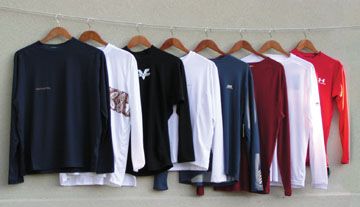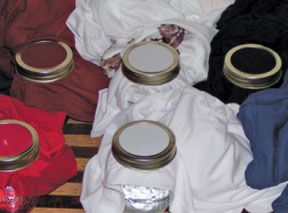
Not too many years ago, racing sailors in the grand prix arena began turning up at regattas with uniformed crew shirts that had an unmistakable synthetic sheen to them. Their owners boasted that they were comfortable to wear, dried in minutes, and offered some measure of protection from the sun’s UV rays. Most of these garments evolved from technical advances in the realm of fabric technology for high-end professional sports. The intent of their inventors was to replace cotton, which can absorb up to 30 percent of its own weight in water (or sweat). Some of these shirts carried claims that they absorbed just 2 percent of their weight in moisture. Others were advertised to have “moisture transport systems” that move perspiration away from the skin to the outer side of the fabric. Each of the shirts we tested is purported to move, or “wick” moisture away from the skin.
For this test, we obtained long-sleeve, base-layer tops from Helly Hansen, Patagonia, Musto, Victoria Wetsuits, Mureadritta, Nike, Under Armour, and Ibex. For the most part, these garments are made of blends using synthetic fibers, principally polyester, though the Ibex product is made of 100 percent merino wool. And each company professes proprietary fabric technology or fiber treatment.
How We Tested
We ran each of the garments through a series of tests. First we evaluated their construction with the assistance of a seamstress—one with 25 years of experience—and rated the shirts accordingly. Then we used the opinions of two testers to judge the feel and comfort of the fabric, and whether the seams and collars were noticeable, and assigned ratings accordingly. Then each shirt was subjected to an evaporation test to judge how well it could transport moisture. Using a heat chamber with an average temperature of 110F for three hours, we affixed a portion of each garment over the opening of a small jar, each with precisely the same amount of water in it. We again measured the water to learn which shirts effectively wicked the moisture. Surprisingly, only the Musto and the Nike jars showed minimal change, If any of the other shirts wicked moisture, it wasn’t measureable. For our penultimate test, we soaked each shirt in brackish seawater, sealed it in a plastic bag and placed it in the sun for two days. They were then taken out and rated regarding their respective resistance odor. Finally, we washed and dried each garment according to the manufacturers’ instructions to check the fabric’s color fastness and dimensional stability.
Patagonia Capilene
Patagonia’s 100 percent polyester shirt is assembled in Mexico and built to be loose-fitting. Five panels comprise the garment: front, back, the two sleeves, and the crew neck collar.
We found the fabric to be soft and comfortable against the skin, with low-profile seams. Patagonia claims no specific ultraviolet protection factor with this shirt, but it does carry a money-back guarantee.
Bottom Line: This shirt dries quickly, but our expert seamstress wasn’t impressed by the single stitching in the seams. At $34 each, these shirts are among the least expensive in our test, and the only ones we tested that come in decorative patterns.
Ibex Woolies
Based in Woodstock, Vermont, Ibex is a 20-person company whose directors are bent on proving that high-quality merino wool can outperform synthetic options in active-wear garments. Made of 100 percent merino wool, Woolies is the company’s lightest base-layer fabric. The shirts are made in the Fiji Islands, come in three colors in both men’s and women’s versions, four sizes and several styles.
Of this group, the Ibex will offer the best insular layer should the weather turn cold, but it would be the least comfortable in hot climates. The downside of wool is that care is paramount. You’ll want to limit wash cycles with products like the Woolie, and you should lay them flat to dry rather than hanging them.
Bottom Line: We like that the Woolie is made from a natural, renewable resource. It carries a $58 price tag, and had the worst rating for resistance to odor.

Helly Hansen Transporter
The Transporter is made of LIFA Versa, Helly Hansen’s lightest base-layer fabric, featuring two layers—LIFA inside and polyester outside. Essentially, LIFA Versa has a polypropylene inner layer and a polyester outer layer.
The Transporter—a crew-neck, long-sleeve garment built in Thailand—felt very smooth on the skin and the seams weren’t noticeable at all. This product is designed to have a loose fit for increased air circulation, but it retains contact with the skin as you move.
Bottom Line: Among the most comfortable tops we evaluated, Helly Hansen’s Transporter scored well in both comfort and construction and carries a reasonable price tag.
Victory Wetsuits Dryshirt
Victory’s RSD or REPEL fabrics reportedly repel water from the outside, but allow sweat to migrate through and evaporate once it reaches the exterior. The base material was developed by 3M using a nylon/polycotton yarn that’s coated with Teflon. Victory recommended a fresh-water rinse for cleaning and advised that you hang-dry it somewhere out of the sun, which might be inconvenient when underway.
Bottom Line: This shirt fared well in most of our tests. Though it’s the heaviest one we evaluated, it absorbs less water by far. Small boat sailors will appreciate, the high SPF number and the solid construction. Nike’s Dri-FIT
Nike’s Dri-FIT concept is based on two layers comprising a single fabric: an inner layer that wicks moisture away, and an outer layer that pushes moisture to the surface and spreads it out over a large area for rapid evaporation.
The Dry-FIT shirt that we tested was made in Mexico and carried a label claiming it’s made of 84 percent polyester and 16 percent spandex. Dry-FIT shirts are sold in numerous colors. The company makes no UPF claim with this shirt, but does produce a UV Reflective garment that sells for $40.
The fabric used to make the Dry-FIT shirt that PS tested has a smooth, silky feel on the skin. The double-stitched seams were particularly smooth and low in profile.
Bottom Line: This shirt is comfortable and fared well in all of our tests. It’s also priced right. The downside is its lack of any ultra violet protection for the wearer.
Under Armour Turf Gear
Built in the Dominican Republic, this snug-fitting shirt was the lightest of all the shirts we tested, but it was also judged the least comfortable by our testers. (Under Armour also makes a looser fitting line called LooseGear.) Under Armour’s shirt comes in a range of sizes from XS to XXXL, and 11 colors and sells for $30.
We were surprised to notice picking along the seam of one shoulder and near the collar on the Under Armour shirt we purchased. (Picking happens when the threads break and come apart in the weave.) Plastic panels in some of the seams also bothered us.
Bottom Line: This was the least comfortable of the eight garments we tested. It had the highest profile seams and some suspicious picking. We’d give it a miss.
Mureadritta
Dubbed Airframe, the fabric in this Italian-made shirt is manufactured from hollow polypropylene fibers woven into cloth. The maker claims that it will absorb no more than 2 percent of its weight in moisture.
Like the Transporter from Helly Hansen, this garment is cut to fit loosely, but it maintains contact with the wearer as he moves.
Bottom Line: This is the most expensive item in our test at $67, and some of the less expensive shirts were more comfortable.
Musto Technical Shirt
The fabric in this shirt is 44 percent polyester, 56 percent nylon pique, which the company claims will absorb only .5 percent of its weight in moisture.
The MicroDry fabric had a natural feel, almost like cotton. It requires more care than some of the other shirts. You can machine wash it, but it can’t be tumbled dry. Also, this shirt developed the second worst odor among the eight we tested.
Bottom Line: One of the most comfortable garments in our test, Musto’s Technical Shirt scored well in every category but the odor resistance test. At $38 each, this would otherwise be a good buy.
Conclusions
Sailors of small boats and those who make long passages will benefit the most from the technical advances in these garments. And the shirts that offer some protection from the sun are even more versatile.
Each shirt had unique features that would appeal to certain individuals. If you get wet a lot on your boat or want a garment with UV protection, the best option is the Dryshirt from Victory Wetsuit. For hot climates, we think either of the garments from Patagonia or Nike would serve you best. If you’re a cold climate sailor, the Ibex shirt would be the likely choice. And the garment from Mureadritta, though relatively expensive, is a good all around choice for either extreme.
However, based on our testing, three shirts stood out for overall performance and comfort: Helly Hansen’s Transporter, Nike’s Dri-FIT, and Musto’s Technical Shirt. Because of its poor resistance to absorbing odor, we rated the Musto a distant third. Nike’s product undersells Helly Hansen’s by $5, scored marginally better for evaporation and fared better in the odor resistance test. Thus it earns top honors in this test by a narrow margin. Finally, we also are recommending the Victory Dryshirt. Because of its outstanding UV protection and water-repellancy, we believe it will be an effective single layer for small boat adventures or dinghy sailing.
Also With This Article
“PS Value Guide: Base-Layer Garments”
“PS Picks”
































